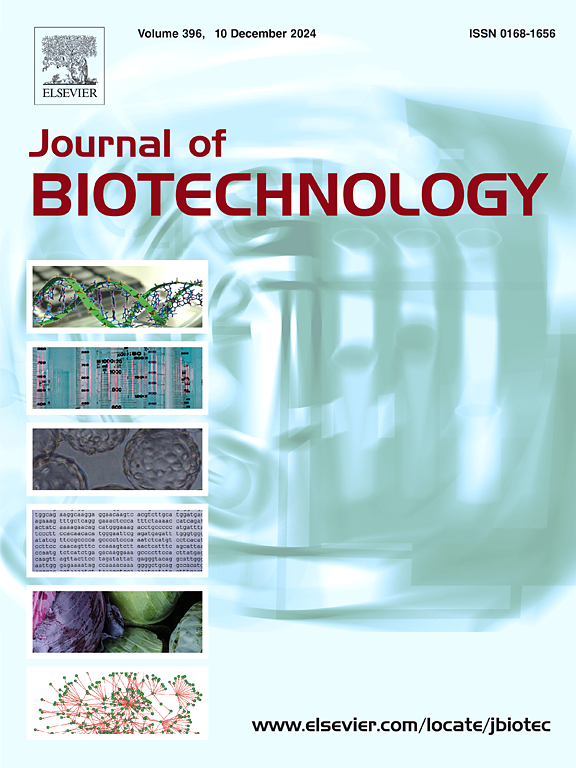利用重组原核凝集素亲和层析法从单克隆抗体中还原高甘露糖糖型。
IF 3.9
2区 生物学
Q2 BIOTECHNOLOGY & APPLIED MICROBIOLOGY
引用次数: 0
摘要
单克隆抗体的聚糖谱是其用作治疗剂的关键质量属性。然而,在大规模生产过程中,糖基化的控制是困难的。一个持续存在的问题是,在细胞培养条件下,高甘露糖聚糖(HM)的增加可能会意外地发生,从而破坏糖基化途径。我们已经开发了一种方法,以去除高甘露糖聚糖从一个生物过程纯化的单抗糖形式的异质混合物。这涉及到使用与琼脂糖珠结合的原核凝集素(RPL-Man2)选择性地与携带hm -聚糖的单克隆抗体可逆结合。从这一步开始的未结合的流动含有剩余的单克隆抗体制备物,其hm -聚糖含量降低。在本文中,我们用两种不同的抗体证明了这种方法的应用,这些抗体来自于中国仓鼠卵巢(CHO)细胞,它们在提高hm -聚糖含量的条件下生长。在生产细胞的培养中存在高水平的甘露糖,以及补充特定的甘露糖酶抑制剂,导致纯化的单克隆抗体含有显著高于标准条件下正常预期的hm甘聚糖水平。通过凝集素层析,我们发现纯化的单抗中的hm -聚糖明显减少。UPLC的荧光检测和质谱分析表明,hm -糖型的去除是选择性的,不影响剩余糖型的谱图。该方法具有用于大规模生物生产的潜力,用于减少或消除单克隆抗体的hm -糖型。本文章由计算机程序翻译,如有差异,请以英文原文为准。
Reduction of high mannose glycoforms from monoclonal antibodies by affinity chromatography using a recombinant prokaryotic lectin
Glycan profiles of monoclonal antibodies are critical quality attributes for their use as therapeutic agents. However, the control of glycosylation can prove difficult during large-scale manufacture. An on-going problem is the increase in high-mannose glycans (HM) that can occur unexpectedly under cell culture conditions that disrupt the glycosylation pathway. We have developed a method for removal of high-mannose glycans from a heterogeneous mixture of mAb glycoforms purified from a bioprocess. This involves the use of a prokaryotic lectin (RPL-Man2) bound to agarose beads to selectively bind reversibly to mAbs carrying HM-glycans. The unbound flow-through from this step contains the remainder of the mAb preparation with a reduced HM-glycan content. In this paper we demonstrate the application of this method using two distinct antibodies derived from Chinese hamster ovary (CHO) cells purposely grown under conditions that enhanced the content of HM-glycans. The presence of an elevated level of mannose in the culture of the producer cells as well as supplementation with a specific mannosidase inhibitor resulted in purified mAbs containing significantly higher levels of HM-glycans than would be expected normally under standard conditions. We showed that HM-glycans in the purified mAbs were reduced significantly by the application of lectin chromatography. Analysis by both UPLC using fluorescence detection as well as by mass spectrometry showed that the removal of the HM-glycoforms was selective and did not affect the profile of the remaining glycoforms. This method has potential for use in large-scale biomanufacturing for the reduction or elimination of HM-glycoforms of mAbs.
求助全文
通过发布文献求助,成功后即可免费获取论文全文。
去求助
来源期刊

Journal of biotechnology
工程技术-生物工程与应用微生物
CiteScore
8.90
自引率
2.40%
发文量
190
审稿时长
45 days
期刊介绍:
The Journal of Biotechnology has an open access mirror journal, the Journal of Biotechnology: X, sharing the same aims and scope, editorial team, submission system and rigorous peer review.
The Journal provides a medium for the rapid publication of both full-length articles and short communications on novel and innovative aspects of biotechnology. The Journal will accept papers ranging from genetic or molecular biological positions to those covering biochemical, chemical or bioprocess engineering aspects as well as computer application of new software concepts, provided that in each case the material is directly relevant to biotechnological systems. Papers presenting information of a multidisciplinary nature that would not be suitable for publication in a journal devoted to a single discipline, are particularly welcome.
 求助内容:
求助内容: 应助结果提醒方式:
应助结果提醒方式:


